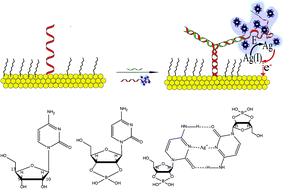Cytidine-rich hydrogel as an electrochemical signal amplification strategy for microRNA detection†
Abstract
Signal amplification strategies increase the complexities of biosensors while improving the response signals. Herein, a novel electrochemical biosensor was developed based on a DNA hydrogel for sensitive analysis using microRNA-21 (miRNA-21) as a detection model. Poly C sequences combined with C–Ag(I)–C hydrogel formed a DNA hydrogel by the unique interaction between the cytosines and silver ions. Thus, with a three-way conjunction structure of DNA, this C–Ag(I)–C hydrogel was constructed as a novel biosensor for the detection of miRNAs. With the assistance of this hydrogel, numerous silver ions gathered around DNA strands, which would amplify the signal. Under these conditions, the silver ions produced distinct square wave voltammetry oxidation peak currents. This electrochemical biosensor we designed exhibited a great linear relationship for the logarithm of the concentration of miRNA-21 from 1 fM to 100 pM with a detection limit of 0.117 fM. Furthermore, our sensors were able to differentiate miRNA-21 from its homologous family with satisfactory responsiveness in the dilute bovine serum system.



 Please wait while we load your content...
Please wait while we load your content...